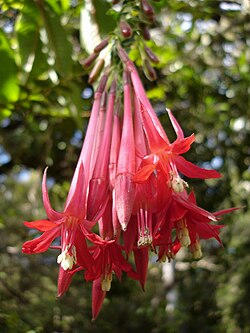Description
It is a medium evergreen shrub, growing to 2–4 m tall, rarely to 6 m, with a spreading, open habit. It has large, hairy mid-green leaves and red petioles. It has large drooping corymbs up to 20 cm long borne in late summer and autumn of scarlet red flowers with the individual flowers 3–7 cm long. A white-flowering form exists named 'Alba', with a white tube and scarlet petals. [3] After flowering it bears small red-purple, edible fruit 10–26 mm long. [4] [5]
Fuchsia boliviana is widely grown in shade or part-shade in cooler, subtropical climates. Plants require protection from direct sun and temperatures exceeding 40 °C. The plants are hardy to about −4 °C for short periods. Propagation is by seed or cuttings. [4]
This page is based on this
Wikipedia article Text is available under the
CC BY-SA 4.0 license; additional terms may apply.
Images, videos and audio are available under their respective licenses.

